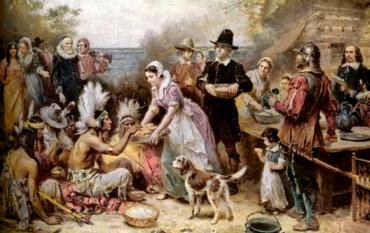 Couple months after the U.S. Constitution was adopted, in the first year of his Presidency, on October 3, 1789, George Washington issued the first official proclamation called “General Thanksgiving” (published in the Massachusetts Centinel newspaper, Wednesday, October 14, 1789) in which we read, “Whereas it is the duty of all nations to acknowledge the providence of Almighty God, to obey His will, to be grateful for His benefits, and humbly to implore His protection and favour; and Whereas both Houses of Congress have, by their joint committee, requested me “to recommend to the people of the United States a DAY OF PUBLICK THANKSGIVING and PRAYER, to be observed by acknowledging with grateful hearts the many and signal favors of Almighty God, especially by affording them an opportunity peaceably to establish a form of government for their safety and happiness..”
Couple months after the U.S. Constitution was adopted, in the first year of his Presidency, on October 3, 1789, George Washington issued the first official proclamation called “General Thanksgiving” (published in the Massachusetts Centinel newspaper, Wednesday, October 14, 1789) in which we read, “Whereas it is the duty of all nations to acknowledge the providence of Almighty God, to obey His will, to be grateful for His benefits, and humbly to implore His protection and favour; and Whereas both Houses of Congress have, by their joint committee, requested me “to recommend to the people of the United States a DAY OF PUBLICK THANKSGIVING and PRAYER, to be observed by acknowledging with grateful hearts the many and signal favors of Almighty God, especially by affording them an opportunity peaceably to establish a form of government for their safety and happiness..”
Read the full text of President Washington’s Proclamation
or view its original publication in The Massachussetts Centinel
However it wasn’t the first official statement. On November 1, 1777, the Continental Congress issued the first official Thanksgiving Proclamation of these United States. Its wording specifically references all three members of the trinity, as well as specifically cites several aspects essential to Christian theology — such as sin, repentance, forgiveness and redemption. The committee appointed to prepare a recommendation to the several states, to set apart a day of public thanksgiving, brought in a report; which was taken into consideration.
After their first harvest, the colonists of the Plymouth Plantation held a celebration of food and feasting in the fall of 1621. Indian chiefs Massassoit, Squanto and Samoset joined in the celebration with ninety of their men in the three-day event. The first recorded Thanksgiving observance was held on June 29, 1671 at Charlestown, Massachusetts by proclamation of the town’s governing council.
The historic proclamation of George Washington opened the way to regular observation of the special day of giving thanks. In fact, such a day was often proclaimed after the victorious battle or similar event. Prior to official call to make Thanksgiving Day a nationwide celebration, each state scheduled its own Thanksgiving holiday at different times, mainly in New England and other Northern states.
Sarah Josepha Hale, a 74-year-old magazine editor Godey’s Lady’s Book, wrote a letter to Lincoln on September 28, 1863, urging him to have the “day of our annual Thanksgiving made a National and fixed Union Festival.” She mentioned in her letter that she had been advocating a national thanksgiving date for 15 years. She explained the reasons to announce the holiday, “You may have observed that, for some years past, there has been an increasing interest felt in our land to have the Thanksgiving held on the same day, in all the States; it now needs National recognition and authoritive fixation, only, to become permanently, an American custom and institution. President Lincoln responded to Mrs. Hale’s request immediately, unlike several of his predecessors, who ignored her petitions altogether.
On October 3, 1863, President Abraham Lincoln issued a proclamation calling for the observance of the fourth Tuesday of November as a national holiday.
In 1939, President Franklin D. Roosevelt moved the holiday to the third Thursday of November (to extend the Christmas shopping season and boost the economy). After a storm of protest, Roosevelt changed the holiday again in 1941 to the fourth Thursday in November, where it stands today. Several Presidents issued their own proclamations on Thanksgiving Day, including Barack Obama.


Leave a Reply